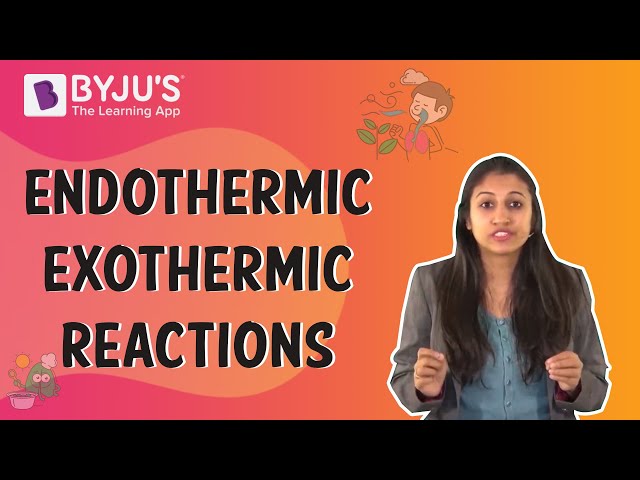What is an Endothermic Reaction?
Endothermic reactions are chemical reactions in which the reactants absorb heat energy from the surroundings to form products. These reactions lower the temperature of their surrounding area, thereby creating a cooling effect. Physical processes can be endothermic as well – Ice cubes absorb heat energy from their surroundings and melt to form liquid water (no chemical bonds are broken or formed).

When a chemical bond is broken, it is usually accompanied by a release of energy. Similarly, the formation of chemical bonds requires an input of energy. The energy supplied/released can be of various forms (such as heat, light, and electricity). Endothermic reactions generally involve the formation of chemical bonds through the absorption of heat from the surroundings. On the other hand, exothermic reactions involve the release of heat energy generated from bond-breakage.
How are Endothermic and Exothermic Reactions Different?
The terms ‘Endo’ and ‘Exo’ have Greek roots, meaning ‘within’ and ‘out’ respectively. As the names suggest, the primary difference between endothermic and exothermic reactions is that the former absorbs heat from the surroundings whereas the latter involves a release of heat.

Some other differences between these types of chemical reactions are tabulated below.
| Endothermic Reaction | Exothermic Reaction |
| The system absorbs heat from the surroundings | The system releases heat into the surroundings |
| The entropy of the surrounding decreases (ΔS <0) | The entropy of the surrounding increases (ΔS>0) |
| Enthalpy change (ΔH) is positive | ΔH is negative |
Recommended Video

Endothermic Process v/s Endothermic Reaction
The human body exploits the endothermic nature of evaporation to cool itself. This is done through the process of sweating. The sweat (produced on the surface of the skin) absorbs heat from the skin to evaporate, thereby creating a cooling effect.
However, sweating is not an exothermic reaction. Chemical reactions can involve the breaking of existing chemical bonds, the formation of new bonds, or both. The evaporation of sweat does not involve any chemical changes but it does involve a change in physical phase (from liquid to vapour). Therefore, evaporation is said to be a physical endothermic process rather than an endothermic reaction.
Any process that absorbs heat from its surroundings is an endothermic process. Therefore, all endothermic reactions are endothermic processes. However, the opposite is not true. Many endothermic processes involve physical changes rather than chemical changes.
Learn about the difference between a Physical change and a Chemical change.
Examples
Endothermic Reaction Examples
- When ammonium chloride (NH4Cl) is dissolved in water, an endothermic reaction takes place. The salt dissociates into ammonium (NH4+) and chloride (Cl–) ions. The chemical equation can be written as follows: NH4Cl (s) + H2O (l) ⟶ NH4Cl (aq) – Heat
- Ammonium nitrate (NH4NO3), an important component in instant cold packs, dissociates into the ammonium cation (NH4+) and the nitrate anion (NO3–) when dissolved in water. These ions go on to form ammonium hydroxide (NH4OH) and nitric acid (HNO3) respectively (by reacting with the OH– and H+ ions in water). This reaction is endothermic in nature since it cools the surroundings by absorbing heat from it.
- The formation of nitric oxide from the reaction between nitrogen and oxygen is endothermic since it involves the absorption of approximately 180.5 kilojoules of heat for every mole of N2 and O2.
Other Endothermic Processes
- The melting of ice to form water.
- Evaporation of liquid water, forming water vapour.
- Sublimation of solid CO2
- The baking of bread.
Energy Level Diagram of an Endothermic Reaction
The simple energy level diagram of endothermic and exothermic reactions are illustrated below. The activation energy is the energy that must be provided to the reactants so that they can overcome the energy barrier and react.

For exothermic reactions, the potential energy of the product is generally lower than that of the reactant. On the other hand, the potential energy of the product in an endothermic reaction is higher than that of the reactants. This gap in the potential energy accounts for the energy that was absorbed by the system during the chemical reaction.
To learn more about endothermic reactions and other important categories of chemical reactions, such as redox reactions, register with BYJU’S and download the mobile application on your smartphone.


Basically every decomposition reaction is an endothermic reaction, right?
Yes, most decomposition reactions are endothermic (because they involve the absorption of heat energy from the surroundings).
Is AgBR ——- At+Br2 a endothermic reaction ??
The decomposition of silver(II) bromide is an endothermic reaction since it requires elevated temperatures (approx. 700 degrees Celsius) or energy in the form of light in order to overcome the activation energy barrier for the reaction.